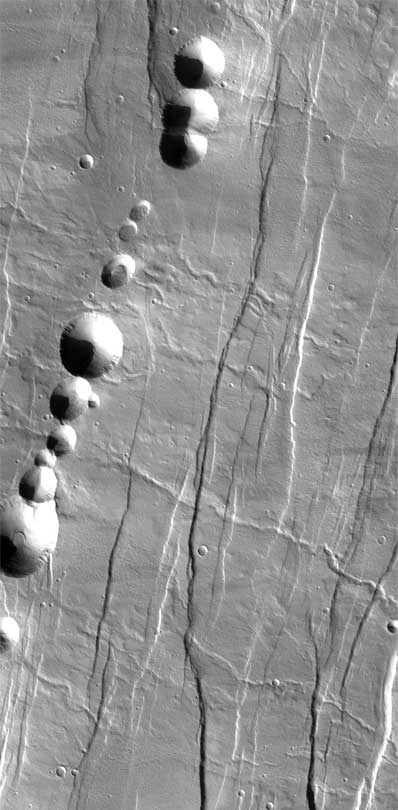Astronomy Picture of the Day
Discover the cosmos! Each day a different image or photograph of our fascinating universe is featured, along with a brief explanation written by a professional astronomer.
Posted on 11/02/2004 3:17:14 AM PST by petuniasevan
Discover the cosmos! Each day a different image or photograph of our fascinating universe is featured, along with a brief explanation written by a professional astronomer.
Explanation: What causes storms on Saturn? To help find out, scientists commanded the robot Cassini spacecraft now orbiting Saturn to inspect a circulating band of clouds nicknamed "Storm Alley." This westwardly moving cloud ring has been unusually active since the beginning of 2004, spawning white swirling storms and dark storms ringed by sprawling white clouds all cascading around the gas giant. The rogue band, as well as part other parts of south Saturn, were imaged in stunning detail in a very specific band of infrared light that passes through Saturn's upper haze relatively unblurred. The result was then digitally sharpened, showing more cloud detail but creating fake image artifacts such as a surrounding ring. Speculation on the nature of past Saturn storms included convective motions of small amounts of ammonia and water, seasons, and shadowing effects of the great ring system. Although the above image provides data and clues, the power behind Saturn's storms still remains a mystery.
Strings of depressions dotting the Martian landscape indicate that seismic activity - marsquakes - may still be reshaping the surface of the planet, according to Dr. David Ferrill of Southwest Research Institute in a paper published in GSA Today. These pit chains occur along dilational faults, partially filled or open cavities that served as conduits for past groundwater flow.
"These faults could now serve as reservoirs for water or ice, making these locations of potentially great interest to the scientific community searching for signs of life on Mars," said Ferrill, a senior program manager at SwRI.
"Astrobiologists consider subsurface aquifer systems high-priority targets for a potential Martian fossil record," said Danielle Wyrick, an SwRI planetary geologist who co-authored the GSA Today article. "Detecting underground water is difficult because current Mars data show only the surface. Pit chains are easy-to-recognize features that give us clues to what’s going on below the surface, including prospective groundwater systems."
 This image from the THEMIS instrument on the Odyssey spacecraft shows details of normal faults and a pit chain on the surface of Mars. |
"The pit craters are larger and better preserved on Mars than on Earth because the surface erosion and higher gravity on Earth result in smaller pits that are rapidly erased, sometimes within decades," said Ferrill. In many areas of Mars, pit crater chains appear to be some of the youngest features, postdating drainage channels, faulting and impact craters. Using visible spectrum image data of Mars from the Thermal Emission Imaging System on the Odyssey spacecraft, the team mapped pit crater outlines, surface drainage channels and fault traces. Pit craters can be observed at all stages of formation. The smallest pits have apparently flat floors with surface textures similar to the surrounding topographic surface; the steeper pit walls are smooth.
"We deduce that some of these pits are youthful, perhaps even actively forming, because surface subsidence has not destroyed the original surface of in-falling material," explained Ferrill. Laboratory physical analog modeling also supports these observations. Based on analysis of Mars data, scientists simulated slip on a normal fault using unconsolidated dry white or dyed sand to represent Mars surface materials. Constant thickness rigid wooden or aluminum plates, with or without an overlying layer of cohesive powder, represented dilating fissures beneath the sand. Scientists initially placed the plates edge-to-edge and created tabular voids by progressively separating the plates to simulate fault slip. "Our physical models reproduced most pit chain morphologies observed on Mars," said Ferrill.
SwRI is an independent, nonprofit, applied research and development organization based in San Antonio, Texas, with more than 2,800 employees and an annual research volume of more than $350 million.

YES! You too can be added to the APOD PING list! Just ask!
Thank You.
bttt
Great images!
Thank you!
That pit chain looks more like an string of meteroid strikes.
Thanks.
I swear those look like hills not pits. Optical delusion?
One's eye has a bias relative to the direction of light on an object. Thus, rotate the picture until your eye sees the stream valleys as depressions. The pits should also then appear to be pits and not hills.
SwRI BUMP -- yee-hah!!!!
The photo of the Storm Alley on Saturn is excellent!
I haven't seen an Astronomy Picture of the Day posted since early November. Although I didn't comment often, I viewed nearly every one. I miss your contribution.
Thanks. That NASA site is so huge that I've never covered every section.
If it were more methodical it would be exploring, but it's not. Therefor it's sploring.
Disclaimer: Opinions posted on Free Republic are those of the individual posters and do not necessarily represent the opinion of Free Republic or its management. All materials posted herein are protected by copyright law and the exemption for fair use of copyrighted works.